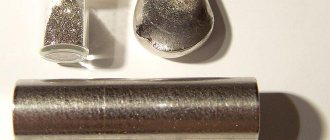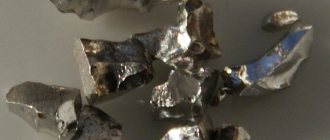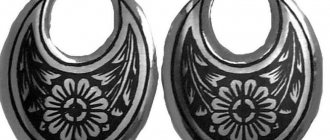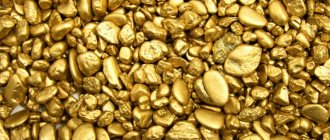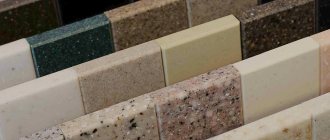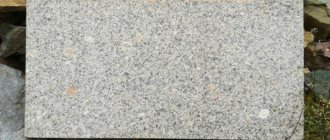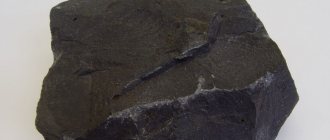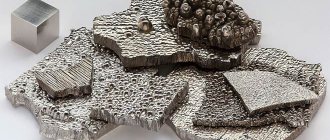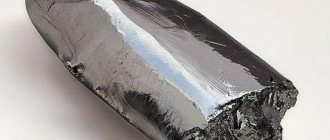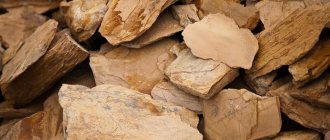| 77 | Iridium |
| Ir 192,217 | |
| 4f145d76s2 | |
Iridium
(lat. Iridium, denoted by the sign
Ir
) is a chemical element with atomic number 77 in the periodic table of chemical elements by D. I. Mendeleev. Iridium is a very hard, refractory, silvery-white transition metal of the platinum group, which has a high density and is comparable in this parameter only to osmium (the densities of Os and Ir are almost equal, taking into account the error of theoretical calculations). Has high corrosion resistance even at temperatures of 2000 °C. It is extremely rare in terrestrial rocks, so a high concentration of iridium in rock samples is an indicator of the cosmic (meteorite) origin of the latter.
Being in nature
The iridium content in the earth's crust is negligible (10−7% by mass). It is much rarer than gold and platinum. It is found together with osmium, rhodium, rhenium and ruthenium. Refers to the least common elements. Iridium is relatively common in meteorites. It is possible that the actual content of the metal on the planet is much higher: its high density and high affinity for iron (siderophilicity) could lead to the displacement of iridium deep into the Earth, into the core of the planet, during its formation from the protoplanetary disk. A small amount of iridium has been discovered in the photosphere of the Sun.
Iridium is found in minerals such as nevyanskite, sysertskite and aurosmiride.
Deposits and production
Primary deposits of osmic iridium are located mainly in peridotite serpentinites of folded regions (South Africa, Canada, Russia, USA, New Guinea).
The annual production of iridium on Earth (as of 2009) is about 3 tons. In 2015, 7.8 tons (251 thousand troy ounces) were produced. In 2016, the price per kilogram was about 16.7 thousand dollars (520 US dollars per troy ounce).
Dinosaurs and the “gift” of the Universe
Where is the iridium, and where are the dinosaurs, what is the connection... According to many scientists, it is direct.
According to the generally accepted theory, during the emergence and formation of planets, stratification occurs - heavier elements are “attracted” to the core of the planet, the lighter the element, the higher it is towards the surface. Therefore, there should not be very heavy iridium on the surface. Where did heavy platinum come from on the surface of the Earth - from space.
Why dinosaurs became extinct - a link in the same chain. Paleontologists, geologists and other scientists believe that the cause of the extinction of dinosaurs was a meteorite fall. Moreover, the time (65 million years ago) and place (Yucatan Peninsula) are called. The crater from the fall turned out to be quite large - 180 km in diameter and 900 meters in depth. Dust clouds obscured the Sun for several years. Plants died, then herbivores died out of starvation, then carnivores (there was nothing left to eat). The ecological system collapsed.
It’s sad: along with dinosaurs, flying dinosaurs went extinct on land, and many species of mollusks and waterfowl reptiles went extinct in the sea.
Iridium anomalies confirm the hypothesis. They were found in marine sediments, in a clay layer that formed 65 million years ago.
And the bones of dead dinosaurs contain an abnormally high amount of iridium, which indirectly confirms the theory of an asteroid fall.
What does iridium have to do with it, the persistent and inquisitive reader will ask. With asteroids.
The Yucatan asteroid (like many others) brought a large amount of rare metals to the Earth from deep space.
We recommend: BRONZE - an alloy for all times and peoples
In total, more than 200 meteorite craters have been explored on the surface of the Earth.
It turns out that the precious metal originated from outer space and is a gift from the Universe.
Informative: scientists have calculated that the entire supply of terrestrial platinum group metals would fit into 160 asteroids, each 20 km in diameter.
Rainbow metal
The metal was discovered and given its name by the Englishman S. Tennant, a chemist. While conducting experiments with native platinum, the chemist also examined the solutions remaining from the experiments. And not in vain - in them he discovered multi-colored salts of an unknown element.
Iridium was named after the rainbow (in Greek iris) - a multi-colored miracle.
This is not about the color of the metal, it is about the variety of colors of iridium salts:
- K3IrCl6, IrF6 - golden yellow crystals;
- KIrF6 - white crystals;
- Ir2O3 - blue, blue-black crystals:
- IrCl2 - green crystals;
- Na2IrBr6 - crimson color.
There are iridium compounds colored olive, brown, pink, and golden.
Say a word about clever Klaus
K. Klaus, a Russian chemist, continued his research on iridium. The work was carried out for about two years, and the enthusiastic Klaus literally lived in the laboratory all this time, eating and sleeping there.
The scientist also studied other platinum metals, but it was the rainbow metal that won his heart. Inaccuracies in metal information have been corrected. Klaus suggested that they were admitted because of the study of iridium mixed with ruthenium (also a platinum group). The scientist gave recommendations on the technology for extracting platinum group metals (including iridium).
Receipt
The main source of iridium is anode sludge from copper-nickel production. Au, Pd, Pt, etc. are separated from the concentrate of platinum group metals. The residue containing Ru, Os and iridium is fused with KNO3 and KOH, the alloy is leached with water, the solution is oxidized with O2, OsO4 and RuO4 are distilled off, and the precipitate containing iridium is fused with Na2O2 and NaOH, the alloy is treated with aqua regia and a solution of NH4Cl, precipitating iridium in the form of a complex compound (NH4)2[IrCl6], which is then calcined to obtain the metal - iridium. A promising method for extracting iridium from solutions is the extraction of hexachloroiridates with higher aliphatic amines. The use of ion exchange is promising for separating iridium from base metals. To extract iridium from minerals of the iridium osmide group, the minerals are fused with barium oxide, treated with hydrochloric acid and aqua regia, OsO4 is distilled off, and iridium is precipitated in the form of (NH4)2[IrCl6].
Biological role
Does not play any biological role. Iridium metal is non-poisonous, but some iridium compounds, such as its hexafluoride (IrF6), are very poisonous.
Iridium - element 77 of the periodic table
The atomic mass of element No. 77 is 192.2. In the periodic table it is located between osmium and platinum. And in nature it is found mainly in the form of iridium osmide, a frequent companion of native platinum. There is no native iridium in nature.
Iridium is a silvery-white metal that is very hard, heavy and durable. According to the data, this is the heaviest element: its density is 22.65 g/cm3, and the density of its constant companion, osmium, the second heaviest, is 22.61 g/cm3. True, most researchers adhere to a different point of view: they believe that iridium is still a little lighter than osmium.
The natural property of iridium (aka platinoid!) is high corrosion resistance. It is not affected by acids either at normal or at elevated temperatures. Even the famous aqua regia is too tough for monolithic iridium. Only molten alkalis and sodium peroxide cause oxidation of element No. 77.
Iridium is resistant to halogens. It reacts with them with great difficulty and only at elevated temperatures. Chlorine forms four chlorides with iridium: IrCl, IrCl2, IrCl3 and IrCl4. Iridium trichloride is most easily obtained from iridium powder placed in a stream of chlorine at 600°C. The only halide compound in which iridium is hexavalent is fluoride IrF6. Finely ground iridium is oxidized at 1000°C and in a stream of oxygen, and depending on the conditions, several compounds of different compositions can be obtained.
Like all platinum group metals, iridium forms complex salts. Among them there are also salts with complex cations, for example [Ir(NH3)6]Cl3 and salts with complex anions, for example K3[IrCl3] · 3H2O. As a complexing agent, iridium is similar to its neighbors on the periodic table.
Pure iridium is obtained from native osmic iridium and from the remains of platinum ores (after platinum, osmium, palladium and ruthenium have been extracted from them). We will not dwell on the technology for producing iridium, referring the reader to the articles “Rhodium”, “Osmium” and “Platinum”.
Iridium is obtained in the form of a powder, which is then pressed into semi-finished products and fused, or the powder is melted in electric furnaces in an argon atmosphere. Pure iridium can be forged when hot, but at normal temperatures it is brittle and cannot be processed in any way.
Physical properties
Iridium is a heavy, silvery-white metal that, due to its hardness, is difficult to machine. Melting point - 2739 K (2466 °C), boils at 4701 K (4428 °C). Crystal structure: face-centered cubic with period a0
=0.38387 nm; electrical resistance - 5.3⋅10−8 Ohm m (at 0 °C), and 2⋅10−7 Ohm m (at 2300 °C); coefficient of linear expansion - 6.5⋅10−6 degrees; normal elastic modulus - 538 GPa; density at 20 °C - 22.65 g/cm³, liquid iridium - 19.39 g/cm³ (2466 °C).
Metal iridium
Iridium is a relatively young metal. Its history dates back to 1804. It was discovered as an unnecessary precipitate from platinum by a scientist from England, chemist S. Tennant. At the same time as iridium, Tennant also discovered osmium. The metal got its name because its salts were multi-colored, similar to a rainbow. Rainbow is translated from ancient Greek as iridium. After Tennant, Karl Klaus researched iridium for two years. It was he who studied iridium inside and out and found out all its chemical properties. Today, research around iridium is still ongoing, although it is considered a full-fledged chemical element and a precious metal.
Today, the cost of iridium according to the Central Bank of the Russian Federation is 3107.97 rubles/gram.
Chemical properties
Iridium is stable in air at ordinary temperatures and heating; when the powder is calcined in a stream of oxygen at 600–1000 °C, it forms a small amount of IrO2. Above 1200 °C it partially evaporates in the form of IrO3. Compact iridium does not react with all known acids and their mixtures at temperatures up to 100 °C. Freshly precipitated iridium black partially dissolves in aqua regia to form a mixture of Ir(III) and Ir(IV) compounds. Iridium powder can be dissolved by chlorination in the presence of alkali metal chlorides at 600–900 °C or by sintering with Na2O2 or BaO2 followed by dissolution in acids. Iridium interacts with F2 at 400–450 °C, and with Cl2 and S at red heat.
Divalent iridium compounds
- IrCl2
- shiny dark green crystals. Poorly soluble in acids and alkalis. When heated to 773 °C, it decomposes into IrCl and chlorine, and above 798 °C - into its constituent elements. Obtained by heating metallic iridium or IrCl3 in a stream of chlorine at 763 °C. - IrS
is a shiny dark blue solid. Slightly soluble in water and acids. Dissolves in potassium sulfide. It is obtained by heating iridium metal in sulfur vapor.
Trivalent iridium compounds
- Ir2O3
is a dark blue solid. Slightly soluble in water and ethanol. Dissolves in sulfuric acid. It is obtained by lightly calcining iridium(III) sulfide. - IrCl3
is a volatile compound whose color ranges from dark olive to light yellow-green depending on the fragmentation and purity of the product obtained. The density of the dark olive compound is 5.292 g/cm³. Slightly soluble in water, alkalis and acids. At 765 °C it decomposes into IrCl2 and chlorine, at 773 °C into IrCl and chlorine, and above 798 °C into its constituent elements. It is obtained by the action of chlorine containing traces of CO on iridium heated to 600 °C under bright illumination by direct sunlight or a burning magnesium tape. Under these conditions, pure iridium chloride is obtained after 15-20 minutes. - IrBr3
- olive green crystals. Soluble in water, slightly soluble in alcohol. Dehydrates when heated to 105-120 °C. When heated strongly, it decomposes into elements. Prepared by reacting IrO2 with hydrobromic acid. - Ir2S3
is a brown solid. Decomposes into elements when heated above 1050 °C. Slightly soluble in water. Dissolves in nitric acid and potassium sulfide solution. It is obtained by the action of hydrogen sulfide on iridium (III) chloride or by heating powdered metal iridium with sulfur at a temperature not exceeding 1050 °C in a vacuum.
Quadrivalent iridium compounds
- IrO2
are black tetragonal crystals with a rutile-type lattice.
Density - 3.15 g/cm³. Slightly soluble in water, ethanol and acids. Reduced to metal by hydrogen. Thermally dissociates into elements when heated. It is obtained by heating powdered iridium in air or oxygen at 700 °C, heating IrO2* n
H2O. - IrF4
is a yellow oily liquid that decomposes in air and is hydrolyzed by water. melting point 106 °C. Prepared by heating IrF6 with iridium powder at 150 °C. - IrCl4
is a hygroscopic brown solid. It dissolves in cold water and decomposes with warm (water). It is obtained by heating (600–700 °C) metallic iridium with chlorine at elevated pressure. - IrBr4
is a blue substance that diffuses in air. Soluble in ethanol; in water (with decomposition), dissociates when heated into elements. It is obtained by reacting IrO2 with hydrobromic acid at low temperature. - IrS2
is a brown solid. Slightly soluble in water. It is obtained by passing hydrogen sulfide through solutions of iridium (IV) salts or by heating powdered metal iridium with sulfur without access of air in a vacuum. - Ir(OH)4
(IrO2 2H2O) is formed by neutralizing solutions of chloroiridates (IV) in the presence of oxidizing agents.
A dark blue precipitate of Ir2O3 nH2O
precipitates when chloroiridates (III) are neutralized with alkali and is easily oxidized in air to IrO2. Practically insoluble in water.
Hexavalent iridium compounds
- IrF6
- yellow tetragonal crystals. melting point 44 °C, boiling point 53 °C, density - 6.0 g/cm³. Under the influence of metallic iridium it turns into IrF4, and is reduced by hydrogen to metallic iridium. It is produced by heating iridium in a fluorine atmosphere in a fluorite tube. Strong oxidizing agent, reacts with water and nitrogen monoxide:
2IrF6 + 10H2O → 2Ir(OH)4 + 12HF + O2↑ IrF6 + NO → NO[IrF6]
- IrS3
is a gray, slightly water-soluble powder. It is obtained by heating powdered metal iridium with excess sulfur in a vacuum. Strictly speaking, it is not a compound of hexavalent iridium, since it contains an SS bond.
The highest oxidation states of iridium (+7, +8, +9) were obtained at very low temperatures in the compounds [(η2-O2)IrO2]+, IrO4 and [IrO4]+. Lower oxidation states are also known (+1, 0, −1, −3), for example [Ir(CO)Cl(PPh3)]2, Ir4(CO)12, [Ir(CO)3(PPh3)]1−, [Ir(CO)3]3−.
Mining locations
The chemical element is found in alloy form in folded earth rocks of the mountains of Russia, peretonite rocks located in South Africa, Kenya, South America, etc.
Where there is platinum, there is also iridium.
About the characteristics of metal as a chemical element:
Characteristic Designation, meaning
| Iridium is represented by the symbol | Ir |
| Number in the periodic table | 77 |
| Atomic weight | 192.22 amu |
| Oxidation states | From 1 to 6 (5 not included) |
| Density at room temperature | 22.7 g/cm^3 |
| Density in liquid state | 19.39 g/cm^3 |
| Melting | At 2300 degrees Celsius |
| Boiling of liquid iridium | At 45 degrees Celsius |
| Has a crystal lattice | Face-centered cube |
The element is found in different colors, the most common is white - KIrF6, lemon - IrF5, gold - K3IrCl6, light green - Na3IrBr6, pink - Cs3IrI6, crimson - Na2IrBr6, dark blue - IrI3. The variety of colors is due to the presence of various salts in iridium.
By the way, the metal got its name due to this variety of colors. Iris is the goddess of the rainbow in Greek mythology.
Application
Of particular interest as a source of electricity is its nuclear isomer, iridium-192m2 (half-life 241 years).
Alloys with W and Th are materials for thermoelectric generators, with Hf are materials for fuel tanks in spacecraft, with Rh, Re, W are materials for thermocouples operated above 2000 °C, with La and Ce are materials for thermionic cathodes.
Iridium is also used to make pen nibs. A small ball of iridium can be found on the tips of nibs and ink rods, and is especially visible on gold nibs, where it is a different color from the nib itself.
Iridium in paleontology and geology is an indicator of the layer that formed immediately after the fall of meteorites.
Iridium, along with copper and platinum, is used in spark plugs of internal combustion engines (ICE) as a material for the manufacture of electrodes, making such plugs the most durable (100-160 thousand km of vehicle mileage) and reducing the requirements for sparking voltage. The first company to use iridium, thereby improving the quality of spark plugs, was the Japanese company NGK. Initially used in aviation and racing cars, then, as the cost of production decreased, it began to be used in mass-produced cars. Currently, such spark plugs are available for most engines, but are the most expensive.
Iridium-192 is a radionuclide with a half-life of 74 days, widely used in flaw detection, especially in conditions where generating sources cannot be used (explosive environments, lack of supply voltage of the required power).
Platinum-iridium alloy has great mechanical strength and does not oxidize. In particular, the kilogram standard is made from this alloy.
In 2013, iridium was used for the first time in the world in the production of official coins by the National Bank of Rwanda, which issued a coin made of pure metal of 999 purity. An iridium coin was issued in the denomination of 10 Rwandan francs.
